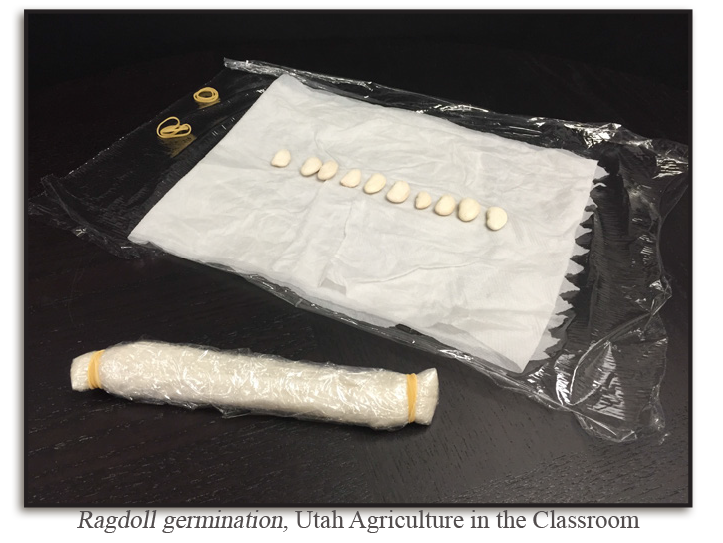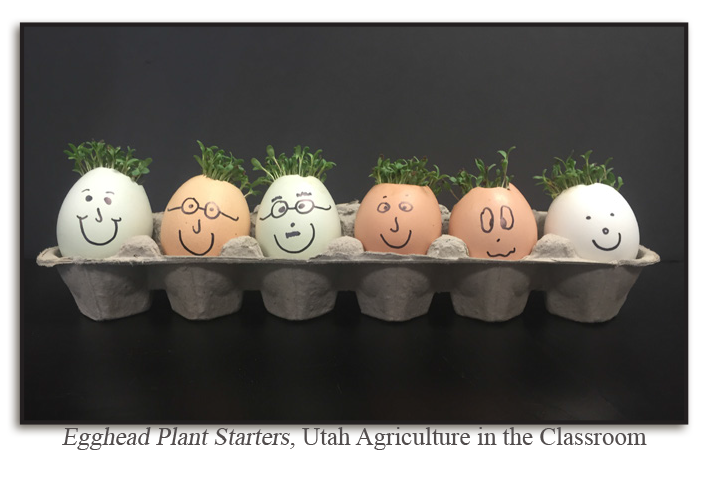How Does Your Garden Grow? (Grades K-2)
Students discover the needs of a seed to germinate and the needs of a plant to grow while exploring the life stages of a flowering plant.
Background
Lesson Activities
Recommended Companion Resources
Credits
Author
Lynn Wallin | Utah Agriculture in the Classroom
Standards
Texas Content Area Standards
-
ELA: K.110.2.b.1
Developing and sustaining foundational language skills: listening, speaking, discussion, and thinking - - oral language. The student develops oral language through listening, speaking, and discussion.
- ELA: K.1.C: The student is expected to share information and ideas by speaking audibly and clearly using the conventions of language.
- ELA: K.1.D: The student is expected to work collaboratively with others by following agreed-upon rules for discussion, including taking turns.
-
ELA: K.110.2.b.5
Comprehension skills: listening, speaking, reading, writing, and thinking using multiple texts. The student uses metacognitive skills to both develop and deepen comprehension of increasingly complex texts.
- ELA: K.5.G: The student is expected to evaluate details to determine what is most important with adult assistance.
-
ELA: 1.110.3.b.1
Developing and sustaining foundational language skills: listening, speaking, discussion, and thinking - - oral language. The student develops oral language through listening, speaking, and discussion.
- ELA: 1.1.C: The student is expected to share information and ideas about the topic under discussion, speaking clearly at an appropriate pace and using the conventions of language.
- ELA: 1.1.D: The student is expected to work collaboratively with others by following agreed-upon rules for discussion, including listening to others, speaking when recognized, and making appropriate contributions.
-
ELA: 1.110.3.b.6
Comprehension skills: listening, speaking, reading, writing, and thinking using multiple texts. The student uses metacognitive skills to both develop and deepen comprehension of increasingly complex texts.
- ELA: 1.6.G: The student is expected to evaluate details to determine what is most important with adult assistance.
-
ELA: 2.110.4.b.1
Developing and sustaining foundational language skills: listening, speaking, discussion, and thinking -- oral language. The student develops oral language through listening, speaking, and discussion.
- ELA: 2.1.C: The student is expected to share information and ideas that focus on the topic under discussion, speaking clearly at an appropriate pace and using the conventions of language.
- ELA: 2.1.D: The student is expected to work collaboratively with others by following agreed-upon rules for discussion, including listening to others, speaking when recognized, making appropriate contributions, and building on the ideas of others.
-
ELA: 2.110.4.b.6
Comprehension skills: listening, speaking, reading, writing, and thinking using multiple texts. The student uses metacognitive skills to both develop and deepen comprehension of increasingly complex texts.
- ELA: 2.6.G: The student is expected to evaluate details read to determine key ideas.
-
Math: K.111.2.b.2
Number and operations. The student applies mathematical process standards to understand how to represent and compare whole numbers, the relative position and magnitude of whole numbers, and relationships within the numeration system.
- Math: K.2.A: The student is expected to count forward and backward to at least 20 with and without objects.
- Math: K.2.B: The student is expected to read, write, and represent whole numbers from 0 to at least 20 with and without objects or pictures.
- Math: K.2.C: The student is expected to count a set of objects up to at least 20 and demonstrate that the last number said tells the number of objects in the set regardless of their arrangement or order.
-
Math: K.111.2.b.3
Number and operations. The student applies mathematical process standards to develop an understanding of addition and subtraction situations in order to solve problems.
- Math: K.3.A: The student is expected to model the action of joining to represent addition and the action of separating to represent subtraction.
-
Math: 1.111.3.b.2
Number and operations. The student applies mathematical process standards to represent and compare whole numbers, the relative position and magnitude of whole numbers, and relationships within the numeration system related to place value.
- Math: 1.2.C: The student is expected to use objects, pictures, and expanded and standard forms to represent numbers up to 120.
-
Math: 1.111.3.b.3
Number and operations. The student applies mathematical process standards to develop and use strategies for whole number addition and subtraction computations in order to solve problems.
- Math: 1.3.B: The student is expected to use objects and pictorial models to solve word problems involving joining, separating, and comparing sets within 20 and unknowns as any one of the terms in the problem such as 2 + 4 = [ ]; 3 + [ ] = 7; and 5 = -3.
- Math: 1.3.D: The student is expected to apply basic fact strategies to add and subtract within 20, including making 10 and decomposing a number leading to a 10.
-
Math: 2.111.4.b.4
Number and operations. The student applies mathematical process standards to develop and use strategies and methods for whole number computations in order to solve addition and subtraction problems with efficiency and accuracy.
- Math: 2.4.A: The student is expected to recall basic facts to add and subtract within 20 with automaticity.
- Math: 2.4.C: The student is expected to solve one-step and multi-step word problems involving addition and subtraction within 1,000 using a variety of strategies based on place value, including algorithms.
-
Social Studies: 2.113.13.c.16
Social studies skills. The student communicates in written, oral, and visual forms. The student is expected to:
- Social Studies: 2.113.13.c.16.E: communicate information visually, orally, or in writing based on knowledge and experiences in social studies
-
Social Studies: K.113.11.c.13
Social studies skills. The student applies critical-thinking skills to organize and use information acquired from a variety of valid sources, including technology. The student is expected to:
- Social Studies: K.113.11.c.13.D: sequence and categorize information
-
Social Studies: K.113.11.c.14
Social studies skills. The student communicates in oral and visual forms. The student is expected to:
- Social Studies: K.113.11.c.14.C: communicate information visually, orally, or in writing based on knowledge and experiences in social studies
-
Social Studies: 1.113.12.c.16
Social studies skills. The student applies critical-thinking skills to organize and use information acquired from a variety of valid sources, including technology. The student is expected to:
- Social Studies: 1.113.12.c.16.D: sequence and categorize information
-
Social Studies: 2.113.13.c.15
Social studies skills. The student applies critical-thinking skills to organize and use information acquired from a variety of valid sources, including technology. The student is expected to:
- Social Studies: 2.113.13.c.15.D: interpret oral, visual, and print material by sequencing, categorizing, identifying the main idea, predicting, comparing, and contrasting
-
Science: K.112.2.b.11
Earth and space. The student knows that earth materials are important to everyday life. The student is expected to observe and generate examples of practical uses for rocks, soil, and water.
- Science: K.112.2.b.11: Earth and space. The student knows that earth materials are important to everyday life. The student is expected to observe and generate examples of practical uses for rocks, soil, and water.
-
Science: K.112.2.b.12
Organisms and environments. The student knows that plants and animals depend on the environment to meet their basic needs for survival. The student is expected to:
- Science: K.112.2.b.12.A: observe and identify the dependence of plants on air, sunlight, water, nutrients in the soil, and space to grow.
-
Science: K.112.2.b.13
Organisms and environments. The student knows that organisms resemble their parents and have structures and undergo processes that help them interact and survive within their environments. The student is expected to:
- Science: K.112.2.b.13.A: identify the structures of plants, including roots, stems, leaves, flowers, and fruits.
- Science: K.112.2.b.13.C: identify and record the changes from seed, seedling, plant, flower, and fruit in a simple plant life cycle.
-
Science: 1.112.3.b.11
Earth and space. The student knows that earth materials and products made from these materials are important to everyday life. The student is expected to:
- Science: 1.112.3.b.11.A: identify and describe how plants, animals, and humans use rocks, soil, and water.
-
Science: 2.112.4.b.12
Organisms and environments. The student knows that living organisms have basic needs that must be met through interactions within their environment. The student is expected to:
- Science: 2.112.4.b.12.A: describe how the physical characteristics of environments, including the amount of rainfall, support plants and animals within an ecosystem
 Ask students what seeds are used for. Explain that seeds are used to grow new plants and sometimes to eat.
Ask students what seeds are used for. Explain that seeds are used to grow new plants and sometimes to eat. Explain that dormant means to be inactive, like in a deep sleep. Active is the opposite of dormant. Most seeds are dormant until they receive warmth and moisture. When a seed receives the correct amount of moisture and the proper temperature, it will begin to germinate, which means it becomes active and sprouts.
Explain that dormant means to be inactive, like in a deep sleep. Active is the opposite of dormant. Most seeds are dormant until they receive warmth and moisture. When a seed receives the correct amount of moisture and the proper temperature, it will begin to germinate, which means it becomes active and sprouts. Ask the students what plants need to grow. Use the
Ask the students what plants need to grow. Use the  Before beginning this activity, place Velcro on each palm-side finger of the glove and on the back of each laminated sunflower life cycle picture.
Before beginning this activity, place Velcro on each palm-side finger of the glove and on the back of each laminated sunflower life cycle picture.